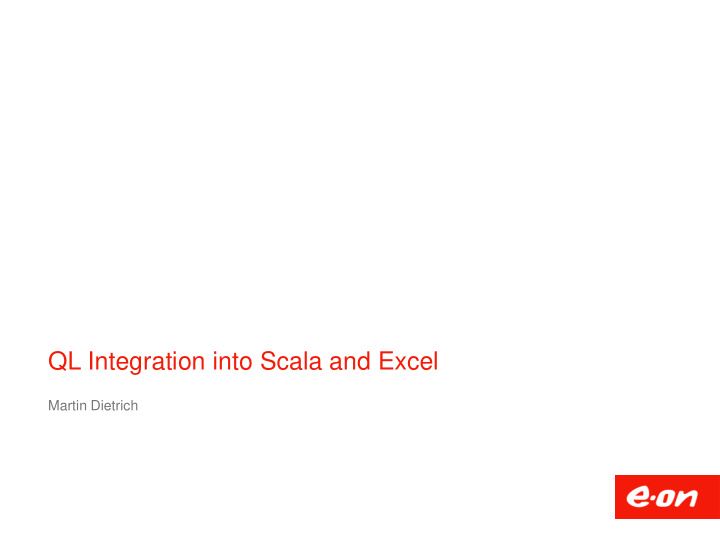



QL Integration into Scala and Excel Martin Dietrich
E.ON Global Commodities Over 1000 professionals, active on over 20 exchanges in more than 40 countries Over 1000 counterparties in more than 50 countries 850,000 trades in 2011 Market energy, mange commodity risk and provide asset optimization services for the E.ON Group and its third party customers Main trading activities: Power, Gas, Emissions, Oil, Coal, Storage Spot, physical forward, options, futures, spread, swaps Swaps, virtual storage, swing gas Physical coal, own fleet of vessels 2
What makes it special? Asset-backed trading Permanent obligation to mark and hedge E.ON‘s asset portfolio Physical delivery with hundreds of physical constraints in fuel supply and power generation Limited liquidity with a significant market share in physical positions Simple products like options and forwards Complex and structured products like VPP and Swing 3
Example: Swing Contract Periodic delivery within a given delivery period at a given strike price Buyer has the right to exercise nomination at short notice (day ahead) Min and max number of exercises Min and max volume per sub period (month) Min and max volume for the whole period (gas year) Coupled American style options – flexible but limited exercise Complex optimization problems solved by dynamic or linear programming 4
Why QuantLib Demand in financial and numerical open source library Advanced, mature and tested Not reimplementing pricing engines, volatility modelling, Brownian bridge and many more 5
Why not exclusively QuantLib Commodity markets are different Additional financial engineering requirements Want to leverage functional programming languages Access identical logic and underlying market data regardless of client Big data, half-hourly profiles or forward curves Interacting with pricing engines from ETRM, Excel or just a simple browser Access the power and performance of a grid from the desktop Agile development 6
Technology Stack 7
Development Dependencies WebSocket JSON eet.apps.quantlib-swig OS/Arch dependent dll 8
Why Excel-DNA Integrating .Net into Excel Packaging tool for script files and assemblies to generate a single XLL 32/64-bit support Asynchronous non-blocking calls Task-based operations (.Net 4.0) Per-call WebSocket using WebSocket4Net Message transfer via JSON using Json.NET Automatically resizing the result range 9
10
11
Interacting with WebSockets 12
Why WebSockets Stateless protocol Real-time full-duplex communication (sending and receiving at a time) Alternative to long polling or Comet Less bandwith usage Initial HTTP request with an upgrade request to the WebSocket protocol Independent in and out streams No request/response cycle 13
Why favouring JavaScript Object Notation JSON is a text-based data format for data exchange Lightwight – no tags, no attributes, less bandwith-intensive Limited data types (strings, numerics, Booleans, arrays, objects, nulls) Java and .Net APIs at hand for (de)serialization Can be persisted in NoSQL databases like MongoDB 14
15
Continuous Integration – the Plugin 16
Continuous Integration – the Plugin 17
Continuous Integration – the Plugin 18
Why Play Full-stack web framework for scala Integrated HTTP server, build system and cache Asynchronous I/O Stateless web application Live code and configuration changes Remote debugging in single threaded environment Type safety Build-in support for JSON validation Build-in support for WebSockets 19
Exposing a WebSocket with Play Specifying the routes Exposing the WebSocket 20
Exposing QuantLib to Play SWIG Simplified Wrapper and Interface Generator Java extension to SWIG writes the Java Native Interface (JNI) SWIG wraps C++ code using Java proxy classes Embedded 32/64bit dll delivered with the jar file, extraction on the fly no need for a separate dll deployment QuantLib in a multi-threaded environment SWIG/QuantLib Objects are not shared between different threads Deregister observer during garbage collection via call back hook Thread local singleton pattern 21
Continuous Integration - QuantLib 22
Continuous Integration - QuantLib 23
Continuous Integration - SWIG 24
Continuous Integration - SWIG 25
Artifactory Central artifact repository for local and remote repositories Integrates with maven, ivy and NuGet 26
Debugging Start from VS in debug mode - debug your c# code 27
Debugging Run play in debug mode Attach remote debugger - debug your scala code 28
Hands-On Pricing a set of vanilla gas options from a spread sheet Sending a pricing request from a web browser Pricing a vanilla option from LexiFi 29
Conclusion QuantLib can be integrated into multi-language/architechture system High throughput Scalable with standard web components Continous Integraiton and TDD Central pricing server 30
Links and Tutorials Principles of Reactive Programming https://www.coursera.org/course/reactive Functional Programming Principles in Scala https://www.coursera.org/course/progfun 31
Recommend
More recommend